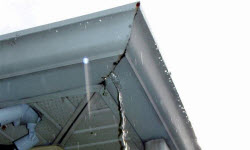Rain gutters are a part of the house that a lot of people don’t give much thought to until something goes wrong. The purpose of your rain gutters is to channel water away from your house when it rains. When your rain gutters are clogged or damaged, the water running off of your roof is not directed away from your home the way it is supposed to be, and this can actually lead to a number of problems. Rain gutters that are not properly maintained could lead to leaks in your basement, damage to your siding, even cracks in the walls or foundation.
They say prevention is the best medicine and because small problems have a way of becoming big problems, it’s best to do whatever you can to prevent damage from occurring in the first place. If your rain gutters are damaged, you need to repair the damage as quickly as possible. On this page we are going to give you some quick tips for rain gutter repair and maintenance so that you can avoid more costly repairs later on.
Preventing Problems With Your Gutters
To prevent damage to your rain gutters, you need to inspect your rain gutters at least a couple of times per year. Walk around your house looking for any obvious signs of damage. If you see holes or cracks in the rain gutters, those will need to be fixed. If there are no obvious signs of damage, you will still want to make sure that the rain gutters are functioning properly. You can turn on your hose and run some water through the rain gutters to make sure that the water is draining properly through the downspouts.
Taking Care of Clogs
One of the most common problems that people have with rain gutters is that clogs will occur. Leaves, twigs, and other debris can get into your rain gutters and clog them. If your rain gutters are not draining properly you will need to get up on a ladder and remove whatever debris is blocking the flow of water.
Repairing Minor Damage
Sometimes rain gutters suffer damage simply by being exposed to the elements. Over time, rain gutters can sag just because gravity is pulling on them. If you notice one section of your rain gutter is sagging, you will have to adjust the height in certain spots to make sure that the water flows freely. If you notice any cracks or holes in your rain gutters, you can patch cracks and small holes with silicone caulking or other products that are designed specifically for gutter repair and maintenance.
Fixing Bigger Problems
When damage to your rain gutters is too great to be fixed with a simple patch, you may need to replace a section of your rain gutters. This can usually be accomplished fairly easily by simply cutting away the damaged section and replacing it with a new piece. A new piece of rain gutter should overlap the old rain gutter by 2 inches on each side. You can screw the new piece into the existing rain gutter and then be sure to seal around the screws and also seal the seams created when putting the new piece in.
Rain gutter repair and maintenance is something that most homeowners can handle as a do-it-yourself project. However, if you feel like you need a little help, you can always use the services of a reputable contractor to get the job done.


This guide is a lifesaver clear, good tips for keeping my gutters healthy. Especially appreciate the reminder about regular cleaning and checking for damage – small fixes now prevent big problems later.